Lev Theremin - from music "from the air" to wiretapping without the "bugs"
Lev Theremin is a physicist, inventor, musician, businessman, winner of the Stalin Prize and a prisoner, as well as a man who is deservedly considered the father of electronic music. The world's first electromusical instrument, the Theremin, became the most famous device of the genius of its time. A tool that allows you to extract sounds without touching it with your hands, but only by manipulating them in front of the antennas.
It is difficult to overestimate the very significance of the fact of creating the first electronic musical instrument , but no less significant inventions of genius remain in the shadows. Not many people know that Theremen became a pioneer in transmitting images over a distance, anticipating the emergence of television, developed a number of unparalleled musical instruments. According to one of the legends, he created a sound alarm system for the Kremlin. In addition, Theremin seriously helped the USSR state security agencies with recording conversations at the embassies of potential adversaries. The last achievement of the Father of Nations even noted the prize of his name. It is interesting that the predecessor I.V. Dzhugashvili, leader and teacher comrade. Ulyanov, as a great music lover, honored the hero of this publication with a personal audience, during which he took lessons on playing the theremin.

The Theremin’s lack of fame among the broad masses, especially at the end of life, and first of all at home, is probably connected precisely with the work of Lev Sergeevich at the “Deep Drilling Bureau”. It should be noted that the 20th and 30th years Theremin was a world celebrity, rented a 6-storey building in New York, where he was working on updating the theremins, inventing new tools, and, according to a number of information requiring verification, protected the Soviet intelligence. Motherland did not forget the hero, and in 1938, Termen was called into the union, he secretly left the States. A year later, in the 39th, Lev Sergeevich received a “reward” from his homeland for a voucher to a corrective labor “dispensary” in Magadan for a period of 8 years (on the fake accusation of preparing for the murder of Kirov). A year later, for rationalization proposals for the construction of a narrow-gauge railway, the Theremin was transferred to a sharashka.
')
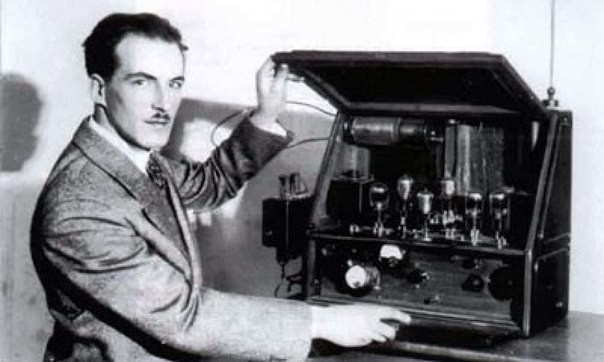
Remarkable is also Termen’s social circle in the 30s in the US, among others it included: Albert Einstein, Charlie Chaplin, Henry Ford, Lucien Dupont, John Rockefeller, Dwight Eisenhower, George Gershwin, Maurice Ravel. No less remarkable are his colleagues in the correctional research institution, for example, the father of Soviet missiles Sergey Korolev was Assistant Termen during his work at Tupolevskaya Sharashka.
Many Termen's inventions are known even less than his rich biography. That is why we have prepared a brief overview of the devices that were decades ahead of their time, invented by Lev Theremin.
The world's first electromusical instrument based on the study of the Theremin dielectric constant of gases. Theremin quickly realized that air could become a capacitor, and a change in the capacitance of a capacitor, in turn, could affect the frequency of electrical oscillations. Thus, in 1920, the scientist turned the installation for the study of the dielectric constant of gases into a musical instrument. The device was a case equipped with two antennas. The design included two generators, one of which had a variable frequency. When the arms move near the first antenna, the capacity of the “air” capacitor changes, which in turn changes the generator frequency. Movement of the hand next to the second antenna allowed to control the amplitude.

The tool allowed in a single-tone mode to play a variety of tunes. Over time, the efforts of Theremin and his followers performing techniques and capabilities of the instrument were improved, which led to the limited distribution of the instrument in Europe and the USA. The emergence of the theremin was noticed by the top leadership of the Land of the Soviets. In 1922, Termen visited Lenin in the Kremlin. As already described above, Ilyich took a keen interest in the invention. On the instructions of the party leader, Termen went on a concert tour of the young Soviet republic as a popularizer of electricity. Already later, in the 30s in the United States began the industrial production of the Theremin. The first production copies were very bulky and fabulously expensive.

Today, a great many classic and not very Theremin are common, there are both analog and digital devices. Some of the modern models of the instrument are equipped with the ability to change the classic sound and various effects. Many of the performers use guitar processors and other effects (distortion, flanger, etc.) to play on the therex, which allows you to significantly expand the range of options for the sound of the instrument.
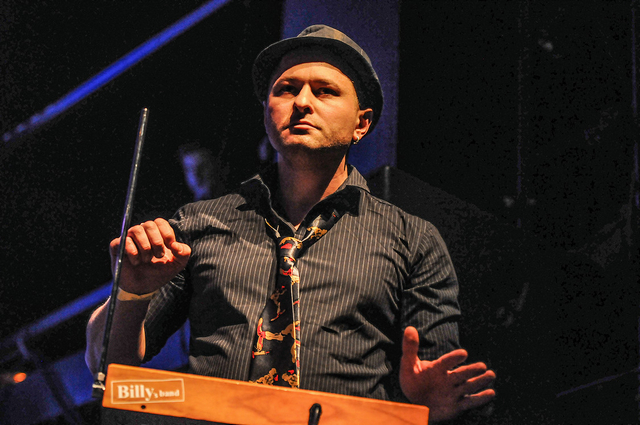
It is interesting, but in the USSR there were no serial production of the theremin, while in the west they continued to be actively used and improved. The tool is not rarely used to create soundtracks for horror films in the 30s - 50s. In addition, many pioneers of psychedelic and electronic music occasionally used the tool for arrangements. Today theremins are in demand in a variety of musical genres. Among the musicians and bands that have used this instrument are such names as: Beatles, Jean-Michel André Jarre, Pink Floyd, Led Zeppelin, Sting.
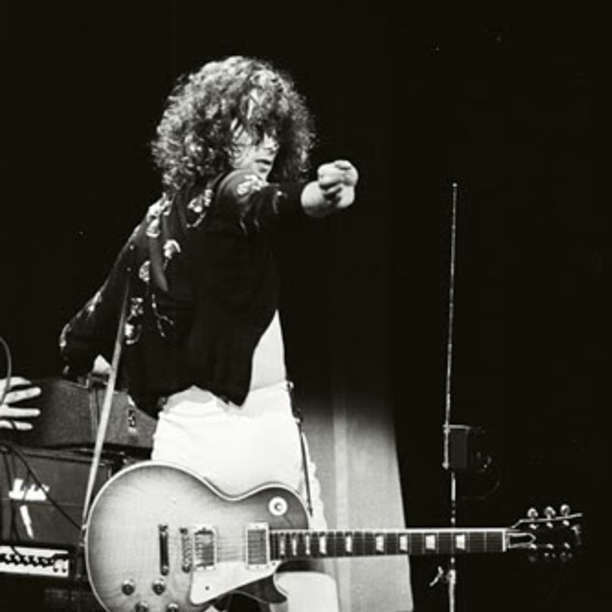
On the basis of theremin, Theremin developed several variants of alarm systems. When crossing the zone in which the antenna was located, a beep was heard. In the 20s, the possibility of installing this system in the Kremlin was considered; there is no reliable information that it was installed. Later in the US, the production of such alarms became a source of substantial income for Lev Termen.
Many sincerely believe that Zvorykin is the father of television, although this is not entirely true. The fact is that, experimenting in the distant 20s, Lev Theremen was able to develop and create a working electromechanical system that allows you to transfer an image at a distance 3 years before Zvorykin. Similar studies in the so-called. mechanical television were carried out before Termen, but did not find practical implementation. According to contemporaries of the inventor, his television system made it possible to transmit the image over a distance in a dynamic manner, to distinguish the faces of people in those cases when they did not make sudden movements.

In 1925, Lev Termen was able to collect 4 models of television devices (two experimental, one demonstration and another one by special order of the USSR Commissariat of Defense) on the basis of devices already created for transmitting the image. Each represented a complex of transmitting and receiving image devices. Theremin called his invention "vision." The electromechanical television of Termena used a special system of synchronously rotating mirror disks and photocells.

The presentation of the "farmer's vision" Termen was held on June 7, 1926 at the Moscow Institute of Physics and Technology, for the second time they saw the system on December 16, 1926 at the Fifth All-Union Congress of Physicists in Moscow. The reaction of the press after this event was not long in coming: they wrote about Termen, as about Soviet Tesla, as about the second Edison. Shortly thereafter, Termen was called to the appropriate authorities, where the scientist was asked to create a television device for the border troops. Newspaper publications on the invention ceased until 1984.
The military presented strict requirements for the installation of the Theremen: work in the open air, in daylight, the presence of a 100-line scan. Subsequently, the experienced military model of the installation was tested personally by the people's commissar for military and naval affairs of the USSR, Clement Voroshilov, in the Kremlin. Using the Termen's vision, Voroshilov could continuously observe the Kremlin courtyard and the people who moved in it.
Despite the enthusiasm of the press and the military-political leadership of the Union, the serial production of the distance visionary was not to be realized. Theremin, shortly after the success of the experiment, went to the United States, while remaining a citizen of the USSR, and there was no time for the “frontier far away viewer”. Moreover, the army of Soviets needed to solve more pressing issues, and with all the desire Voroshilov or anyone else, even for the vital did not always have enough resources.
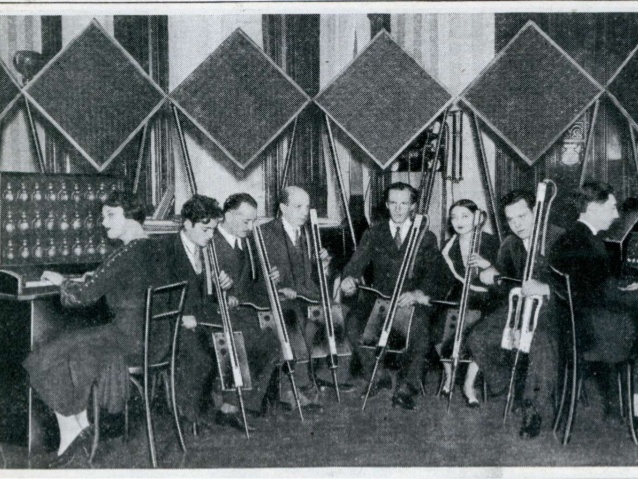
As a cellist, Theremin could not help but try the possibility of the principle implemented in theremin to create other instruments. So in his laboratory in New York, the first electronic cello appeared. The instrument was similar to its acoustic counterpart, but was completely devoid of strings, and a special lever served as a bow. The frequency change was carried out by moving the fingers along the plastic surface of the neck without strings, and a lever was responsible for the amplitude. The sound of the cello resembled the sound of theremin.
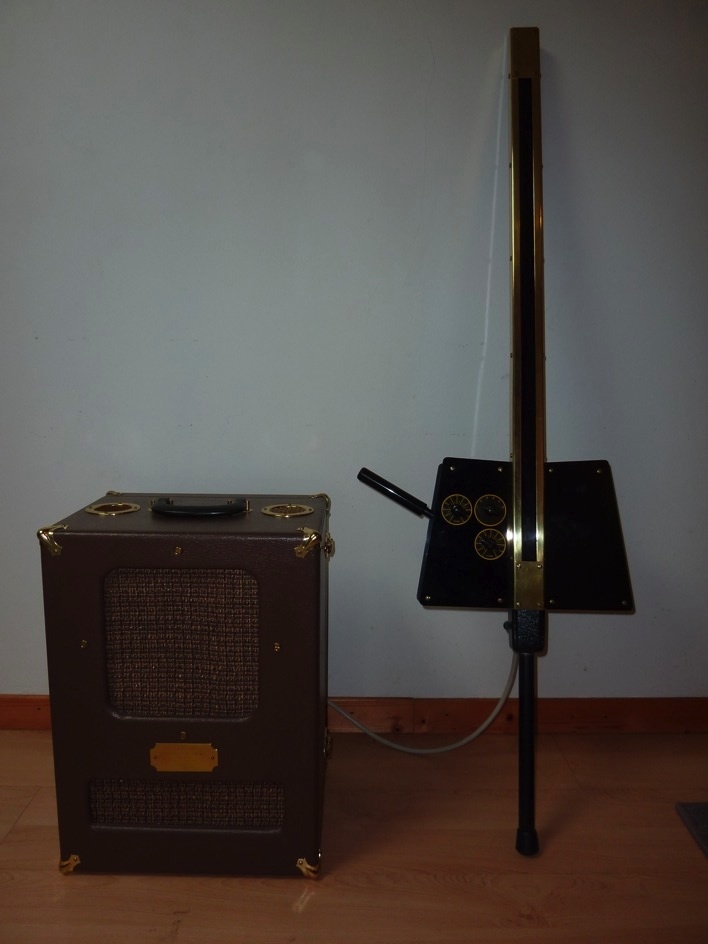
As in the case of the theremin, a characteristic feature of the Termen cello was the monophonic mode of operation, in which it was impossible to extract 2 or more sounds from the instrument simultaneously, which allows the traditional acoustic cello to be made. Judging by the available data, Theremin’s cello was not mass-produced during the lifetime of the inventor himself. At the moment there are several custom versions of the instrument, a small number of photographs of the original cellos have been preserved, allowing us to make a conclusion about their appearance.
Continuing to experiment with electromusical systems in his laboratory in the US, Termen creates a "terpsiton" - a tool that involves sound extraction and light performance in the dance process. In a sense, the very idea of terpsiton was close to modern kinlect devices, despite the archaic (in the modern view) principles on which the tool was created.
The operation of the device, as well as in the theremin and the Theremin cello, was based on the interaction of two generators with a fixed and variable frequency. As in the theremin change of frequency was achieved by changing the distance between the plates of the capacitor (respectively, changing the capacity). In fact, the body of the dancer was one of the capacitor plates, and the second was a metal part that was placed under the floor. As a result of movement of the dancer's body in space, the capacity of the oscillating circuit changed, which led to a change in frequency, and, accordingly, made it possible to extract sounds through the plastic of the dance.

Among other things, the "terpsiton" was equipped with a color-music installation, which responded to the rhythm of the dancer's movements. Each frequency, corresponding to each note, corresponded to lamps of a certain color, which made it possible for additional visualization of sound extraction.
Spending time imprisoned, Termen did not lose heart and found the strength for new inventions. It should be noted that Stalin's little balls differed significantly from the rest of the "institutions" of the GULAG. Normal, compared with the camp, nutrition and relatively human living conditions contributed a lot to the inventions of Lev Sergeyevich.
After working on the cruise missile control system with Korolev and Tupolev, in 1943, while continuing to serve time, Termen creates one of the most sophisticated listening devices for his time - the Zlatoust. The beetle having no analogues in the world was disguised by the gift of the Soviet pioneers to the American ambassador in the form of a USA coat of arms cut out of precious wood. The coat of arms was presented to Ambassador Harriman during a visit to the camp "Artek", on the occasion of the 20th anniversary of the health institution in 1945. Harriman was led to a jewel-inlaid gift.
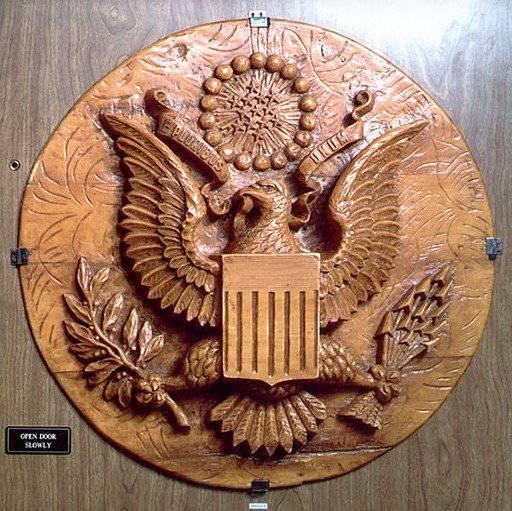
The device, mounted in the coat of arms, did not use any sources of power, magnetic fields, in other words - nothing that could be detected by the special services armed with weapons. The device was driven by microwave radiation, the source of which could be within a radius of 100 meters from the "bug."

"Zlatoust" in the gift of the pioneers listened to the embassy until 1952. When a bug was discovered by chance, the hapless Yankees did not understand what was in front of them. The device consisted of a metal wire, an empty resonator chamber and a membrane. Only 8 years later, in connection with the downed reconnaissance aircraft, the American side announced the discovery of the device.
Continuing to while away the time in Sharashka, Lev Theremin created an even more perfect listening device. “Buran” is an infrared microphone capable of picking up vibrations of window glass. In fact - it was a prototype of what we call laser-tapping, the principle was the same, with the only difference: infrared radiation was used instead of a laser beam.
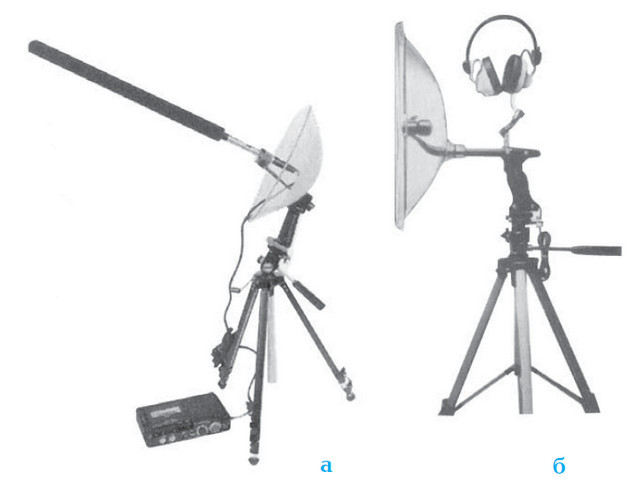
It was for this invention that Termen was conferred the "closed" Stalin Prize of the first degree and the Order relying on it. According to legend, Joseph Stalin, looking at the documents submitted for the award of Theremin, personally crossed out the word "second" in the document with the wording "Stalin Prize of the Second Degree", and wrote "first."
I believe that in this material we have touched far from all the inventions of Lev Theremin. Most likely, the Secret is not yet removed from some of them, especially considering that the inventor worked (at least was listed) in the state security bodies almost until the collapse of the Soviet system.
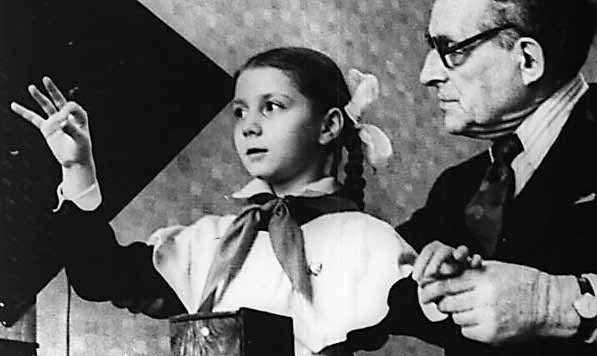
And one more interesting fact: Lev Sergeevich very much liked to say his last name, on the contrary, it turned out to be “not dying,” with such a mindset the inventor lived to be 97 years old. At the end of his life, Termen fulfilled the promise that was once given by V.I. Lenin, in 1991, he became a member of the Communist Party, a few months later the organization ceased to exist.
It is difficult to overestimate the very significance of the fact of creating the first electronic musical instrument , but no less significant inventions of genius remain in the shadows. Not many people know that Theremen became a pioneer in transmitting images over a distance, anticipating the emergence of television, developed a number of unparalleled musical instruments. According to one of the legends, he created a sound alarm system for the Kremlin. In addition, Theremin seriously helped the USSR state security agencies with recording conversations at the embassies of potential adversaries. The last achievement of the Father of Nations even noted the prize of his name. It is interesting that the predecessor I.V. Dzhugashvili, leader and teacher comrade. Ulyanov, as a great music lover, honored the hero of this publication with a personal audience, during which he took lessons on playing the theremin.

The Theremin’s lack of fame among the broad masses, especially at the end of life, and first of all at home, is probably connected precisely with the work of Lev Sergeevich at the “Deep Drilling Bureau”. It should be noted that the 20th and 30th years Theremin was a world celebrity, rented a 6-storey building in New York, where he was working on updating the theremins, inventing new tools, and, according to a number of information requiring verification, protected the Soviet intelligence. Motherland did not forget the hero, and in 1938, Termen was called into the union, he secretly left the States. A year later, in the 39th, Lev Sergeevich received a “reward” from his homeland for a voucher to a corrective labor “dispensary” in Magadan for a period of 8 years (on the fake accusation of preparing for the murder of Kirov). A year later, for rationalization proposals for the construction of a narrow-gauge railway, the Theremin was transferred to a sharashka.
')

Remarkable is also Termen’s social circle in the 30s in the US, among others it included: Albert Einstein, Charlie Chaplin, Henry Ford, Lucien Dupont, John Rockefeller, Dwight Eisenhower, George Gershwin, Maurice Ravel. No less remarkable are his colleagues in the correctional research institution, for example, the father of Soviet missiles Sergey Korolev was Assistant Termen during his work at Tupolevskaya Sharashka.
Many Termen's inventions are known even less than his rich biography. That is why we have prepared a brief overview of the devices that were decades ahead of their time, invented by Lev Theremin.
Theremin
The world's first electromusical instrument based on the study of the Theremin dielectric constant of gases. Theremin quickly realized that air could become a capacitor, and a change in the capacitance of a capacitor, in turn, could affect the frequency of electrical oscillations. Thus, in 1920, the scientist turned the installation for the study of the dielectric constant of gases into a musical instrument. The device was a case equipped with two antennas. The design included two generators, one of which had a variable frequency. When the arms move near the first antenna, the capacity of the “air” capacitor changes, which in turn changes the generator frequency. Movement of the hand next to the second antenna allowed to control the amplitude.

The tool allowed in a single-tone mode to play a variety of tunes. Over time, the efforts of Theremin and his followers performing techniques and capabilities of the instrument were improved, which led to the limited distribution of the instrument in Europe and the USA. The emergence of the theremin was noticed by the top leadership of the Land of the Soviets. In 1922, Termen visited Lenin in the Kremlin. As already described above, Ilyich took a keen interest in the invention. On the instructions of the party leader, Termen went on a concert tour of the young Soviet republic as a popularizer of electricity. Already later, in the 30s in the United States began the industrial production of the Theremin. The first production copies were very bulky and fabulously expensive.

Today, a great many classic and not very Theremin are common, there are both analog and digital devices. Some of the modern models of the instrument are equipped with the ability to change the classic sound and various effects. Many of the performers use guitar processors and other effects (distortion, flanger, etc.) to play on the therex, which allows you to significantly expand the range of options for the sound of the instrument.

It is interesting, but in the USSR there were no serial production of the theremin, while in the west they continued to be actively used and improved. The tool is not rarely used to create soundtracks for horror films in the 30s - 50s. In addition, many pioneers of psychedelic and electronic music occasionally used the tool for arrangements. Today theremins are in demand in a variety of musical genres. Among the musicians and bands that have used this instrument are such names as: Beatles, Jean-Michel André Jarre, Pink Floyd, Led Zeppelin, Sting.

On the basis of theremin, Theremin developed several variants of alarm systems. When crossing the zone in which the antenna was located, a beep was heard. In the 20s, the possibility of installing this system in the Kremlin was considered; there is no reliable information that it was installed. Later in the US, the production of such alarms became a source of substantial income for Lev Termen.
Visionary
Many sincerely believe that Zvorykin is the father of television, although this is not entirely true. The fact is that, experimenting in the distant 20s, Lev Theremen was able to develop and create a working electromechanical system that allows you to transfer an image at a distance 3 years before Zvorykin. Similar studies in the so-called. mechanical television were carried out before Termen, but did not find practical implementation. According to contemporaries of the inventor, his television system made it possible to transmit the image over a distance in a dynamic manner, to distinguish the faces of people in those cases when they did not make sudden movements.

In 1925, Lev Termen was able to collect 4 models of television devices (two experimental, one demonstration and another one by special order of the USSR Commissariat of Defense) on the basis of devices already created for transmitting the image. Each represented a complex of transmitting and receiving image devices. Theremin called his invention "vision." The electromechanical television of Termena used a special system of synchronously rotating mirror disks and photocells.

The presentation of the "farmer's vision" Termen was held on June 7, 1926 at the Moscow Institute of Physics and Technology, for the second time they saw the system on December 16, 1926 at the Fifth All-Union Congress of Physicists in Moscow. The reaction of the press after this event was not long in coming: they wrote about Termen, as about Soviet Tesla, as about the second Edison. Shortly thereafter, Termen was called to the appropriate authorities, where the scientist was asked to create a television device for the border troops. Newspaper publications on the invention ceased until 1984.
The military presented strict requirements for the installation of the Theremen: work in the open air, in daylight, the presence of a 100-line scan. Subsequently, the experienced military model of the installation was tested personally by the people's commissar for military and naval affairs of the USSR, Clement Voroshilov, in the Kremlin. Using the Termen's vision, Voroshilov could continuously observe the Kremlin courtyard and the people who moved in it.
Despite the enthusiasm of the press and the military-political leadership of the Union, the serial production of the distance visionary was not to be realized. Theremin, shortly after the success of the experiment, went to the United States, while remaining a citizen of the USSR, and there was no time for the “frontier far away viewer”. Moreover, the army of Soviets needed to solve more pressing issues, and with all the desire Voroshilov or anyone else, even for the vital did not always have enough resources.
Cello termena

As a cellist, Theremin could not help but try the possibility of the principle implemented in theremin to create other instruments. So in his laboratory in New York, the first electronic cello appeared. The instrument was similar to its acoustic counterpart, but was completely devoid of strings, and a special lever served as a bow. The frequency change was carried out by moving the fingers along the plastic surface of the neck without strings, and a lever was responsible for the amplitude. The sound of the cello resembled the sound of theremin.

As in the case of the theremin, a characteristic feature of the Termen cello was the monophonic mode of operation, in which it was impossible to extract 2 or more sounds from the instrument simultaneously, which allows the traditional acoustic cello to be made. Judging by the available data, Theremin’s cello was not mass-produced during the lifetime of the inventor himself. At the moment there are several custom versions of the instrument, a small number of photographs of the original cellos have been preserved, allowing us to make a conclusion about their appearance.
Tenrpsiton - dance "Kinnekt" 30s
Continuing to experiment with electromusical systems in his laboratory in the US, Termen creates a "terpsiton" - a tool that involves sound extraction and light performance in the dance process. In a sense, the very idea of terpsiton was close to modern kinlect devices, despite the archaic (in the modern view) principles on which the tool was created.
The operation of the device, as well as in the theremin and the Theremin cello, was based on the interaction of two generators with a fixed and variable frequency. As in the theremin change of frequency was achieved by changing the distance between the plates of the capacitor (respectively, changing the capacity). In fact, the body of the dancer was one of the capacitor plates, and the second was a metal part that was placed under the floor. As a result of movement of the dancer's body in space, the capacity of the oscillating circuit changed, which led to a change in frequency, and, accordingly, made it possible to extract sounds through the plastic of the dance.

Among other things, the "terpsiton" was equipped with a color-music installation, which responded to the rhythm of the dancer's movements. Each frequency, corresponding to each note, corresponded to lamps of a certain color, which made it possible for additional visualization of sound extraction.
Zlatoust - confessional of the US Embassy in Moscow
Spending time imprisoned, Termen did not lose heart and found the strength for new inventions. It should be noted that Stalin's little balls differed significantly from the rest of the "institutions" of the GULAG. Normal, compared with the camp, nutrition and relatively human living conditions contributed a lot to the inventions of Lev Sergeyevich.
After working on the cruise missile control system with Korolev and Tupolev, in 1943, while continuing to serve time, Termen creates one of the most sophisticated listening devices for his time - the Zlatoust. The beetle having no analogues in the world was disguised by the gift of the Soviet pioneers to the American ambassador in the form of a USA coat of arms cut out of precious wood. The coat of arms was presented to Ambassador Harriman during a visit to the camp "Artek", on the occasion of the 20th anniversary of the health institution in 1945. Harriman was led to a jewel-inlaid gift.

The device, mounted in the coat of arms, did not use any sources of power, magnetic fields, in other words - nothing that could be detected by the special services armed with weapons. The device was driven by microwave radiation, the source of which could be within a radius of 100 meters from the "bug."

"Zlatoust" in the gift of the pioneers listened to the embassy until 1952. When a bug was discovered by chance, the hapless Yankees did not understand what was in front of them. The device consisted of a metal wire, an empty resonator chamber and a membrane. Only 8 years later, in connection with the downed reconnaissance aircraft, the American side announced the discovery of the device.
"Buran", which did not fly into space
Continuing to while away the time in Sharashka, Lev Theremin created an even more perfect listening device. “Buran” is an infrared microphone capable of picking up vibrations of window glass. In fact - it was a prototype of what we call laser-tapping, the principle was the same, with the only difference: infrared radiation was used instead of a laser beam.

It was for this invention that Termen was conferred the "closed" Stalin Prize of the first degree and the Order relying on it. According to legend, Joseph Stalin, looking at the documents submitted for the award of Theremin, personally crossed out the word "second" in the document with the wording "Stalin Prize of the Second Degree", and wrote "first."
I believe that in this material we have touched far from all the inventions of Lev Theremin. Most likely, the Secret is not yet removed from some of them, especially considering that the inventor worked (at least was listed) in the state security bodies almost until the collapse of the Soviet system.
Dies not

And one more interesting fact: Lev Sergeevich very much liked to say his last name, on the contrary, it turned out to be “not dying,” with such a mindset the inventor lived to be 97 years old. At the end of his life, Termen fulfilled the promise that was once given by V.I. Lenin, in 1991, he became a member of the Communist Party, a few months later the organization ceased to exist.
Source: https://habr.com/ru/post/398435/
All Articles